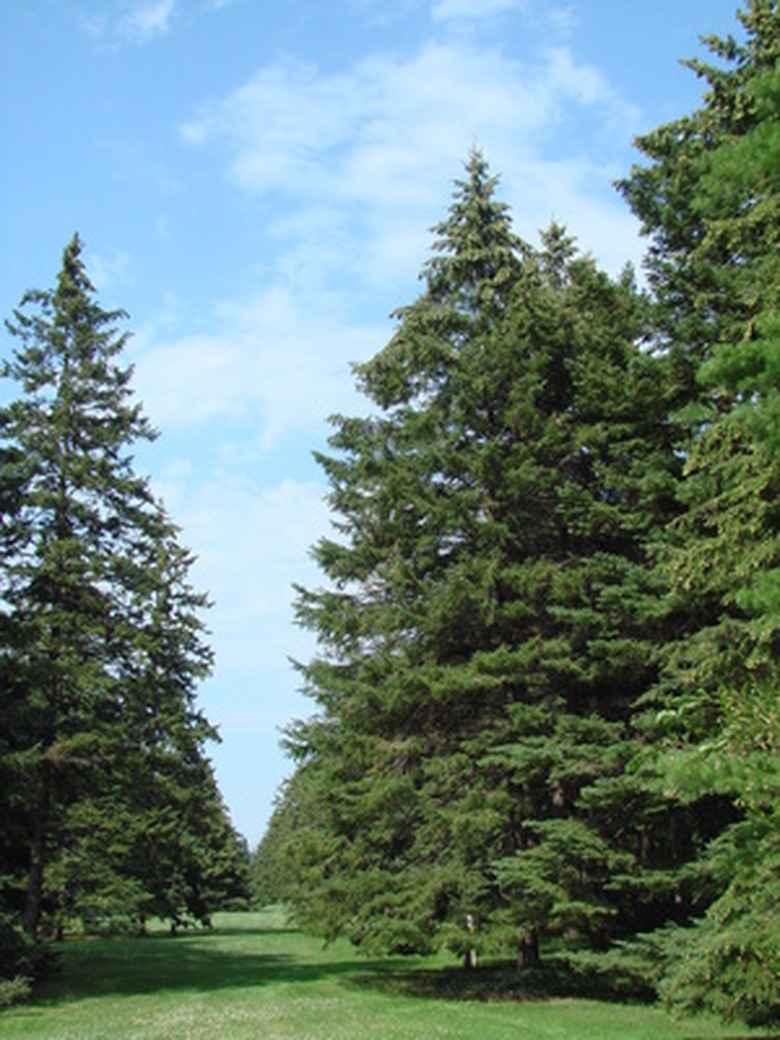Why Are My Pine Trees Dying?
The pines represent a genus of needled evergreens consisting of approximately 115 different species, over 40 of which are native to North America. Generally quite long-lived, a pine's life can be cut short as a result of pest or disease infestation. Careful inspection of your pine trees may indicate why they are dying and allow you take the measures necessary to contain the problem and prevent it from affecting your other conifers
Pine Bark Beetle
Pine bark beetles infest trees during periods of drought. The insects bore into the tree in the spring and lay eggs in the area of the tree between the bark and wood known as the cambium. The hatched larvae tunnel through the cambium as they feed. The damage they cause disrupts water and nutrient movement within the tree. The presence of pitch tubes (masses of resin) on the surface of the tree and brown boring dust is indicative of pine bark beetles. The crown of the infected tree fades to a light yellowish-green or red. Insecticides are ineffective on infested trees.
- The pines represent a genus of needled evergreens consisting of approximately 115 different species, over 40 of which are native to North America.
- The damage they cause disrupts water and nutrient movement within the tree.
Pine Wilt
The Pinewood nematode causes pine wilt by blocking the resin canals of the tree. The blockages interfere with the flow of water and nutrients within the tree resulting in brown droopy needles that remain on the tree. Sap leakage is absent because the resin canals are blocked. The tree will usually die within one month. Since there is no cure for pine wilt, it is recommended that the tree be cut down and the wood be burned or buried promptly.
Dothistroma Needle Blight
Dothistroma needle blight is caused by a fungus that infects and kills pine needles. Initial symptoms of infection appear as deep green bands in addition to yellow and brown spots on the needles. Within two to three weeks, the needles turn completely brown and fall from the tree prematurely. It is usually the lower crown of the tree that is most severely affected. Successive years of severe infection is required to kill the tree. Copper fungicides are useful in controlling the disease.
- The Pinewood nematode causes pine wilt by blocking the resin canals of the tree.
Diplodia Tip Blight
Diplodia tip blight is most commonly seen in old or severely weakened trees and appears as dead brown needles at the end of the current season's new growth. As a result of infection, the needles stop growing and appear stunted in comparison to those that are healthy. The infection spreads until all of the year's new growth has been killed. The disease typically affects the bottom branches of the tree first. Limited disease may be controlled by pruning and proper sanitation procedures. Copper fungicides are required for controlling more widespread disease.
Armillaria Root Rot
The fungus that causes Armillaria root rot is one that naturally exists on decaying trees. It becomes a problem for the roots of healthy trees when it spreads through the soil from the stump of the decaying tree. As the number of infected roots on the once healthy tree increases, it becomes weaker and eventually succumbs to the disease. Visible symptoms include foliage yellowing and stunted growth followed by browning of the needles and tree death. A thick mat of fungal growth between the bark and wood at the base of the tree confirms Armillaria root rot. There is no chemical cure.
- Diplodia tip blight is most commonly seen in old or severely weakened trees and appears as dead brown needles at the end of the current season's new growth.
- The fungus that causes Armillaria root rot is one that naturally exists on decaying trees.
